New partnership announced with Borderless
Sona and Borderless announce an exciting partnership.
Building a staff schedule couldn’t be easier.
Reduce payroll errors with real-time T&A.
Fill 50% more shifts with your own employees.
Ensure shifts are covered even if you're understaffed.
Manage absence requests and approvals.
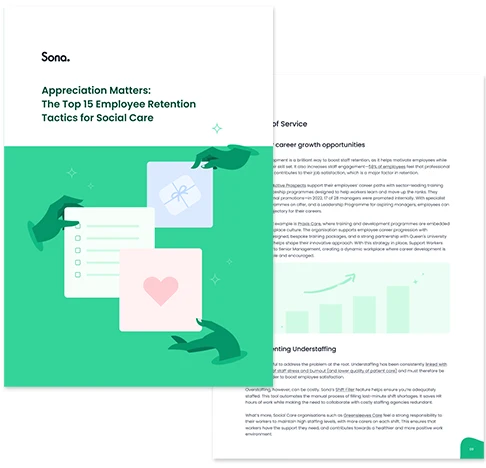
Practical ways to boost team morale with proven examples from across the sector.
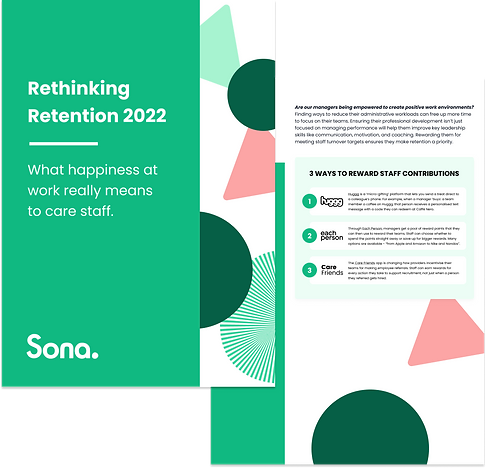
Find out what care employees say matters to them most at work.
Search and view employees with customised permission levels.
Key employment information all in one place.
Store visas, professional certifications and more with easy access.
Control personal and operational details of your staff.

Why are people leaving Social Care, and where are they going?
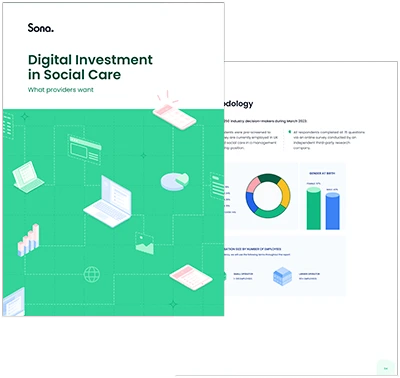
We asked 250 Social Care leaders about their attitudes towards digitisation and their plans for the next 12 months...
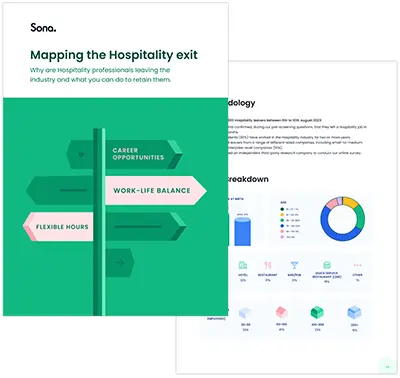
Why are Hospitality workers leaving the industry, and what can you do to retain them?
Share updates with a single click.

Staff can see relevant messages in one place.
Request post-shift feedback from staff.
Recognise staff contributions by sending them praise.
Identify staff at risk of churning.
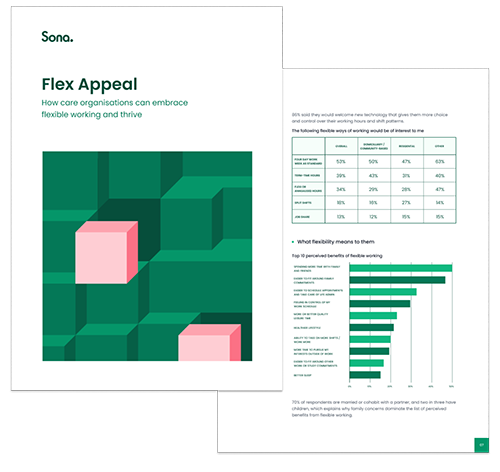
How care organisations can embrace flexible working and thrive.
Maintain quality of care and reduce costs.
Maximise profitability through AI-powered forecasting & scheduling.
Elevate your operational efficiency and guest satisfaction.
Streamline operations across sites.
Developed alongside Social Care experts with decades of combined experience.
See why we are the leading user-friendly, end-to-end platform that prioritises both efficiency and wellbeing.
The Sona Partner Network is an ecosystem of solution experts and complementary technologies.

Give staff greater visibility of shifts available to work, with a simple "shift claim" process to increase their income.
Improve employee engagement and retention with a seamless employee communication platform.
Happier staff provide greater customer experiences, which in turn drives return rates, revenues and recommendations.

Give staff greater visibility of shifts available to work, with a simple "shift claim" process to increase their income.
Improve employee engagement and retention with a seamless employee communication platform.
Happier staff provide greater customer experiences, which in turn drives return rates, revenues and recommendations.

Meet the Sona team online with our webinar series or in-person at an event near you.
New research, insights, and strategies for frontline leaders.
Downloadable templates, reports and guides from Sona.
Stay up to date with the latest Sona news and research.
Learn how our customers are transforming their people operations.
| 3 min read
Sona and Borderless announce an exciting partnership.
| 2 min read
Sona and Found by Lottie announce an exciting partnership.
| 4 min read
Remove operational errors, drive efficiency, and help your team spend less time on admin with a unified solution.
PUBLISHED: February 2025
Download the report to learn how hospitality operators are embracing AI challenges and opportunities in 2025.
PUBLISHED: January 2025
Reveal the most important metrics in 2025!
PUBLISHED: December 2024
This infosheet is packed with practical insights to drive high-quality, low-regret WFM purchases.Social Care, Digital Transformation, Video
92% of social care providers believe digitalisation is crucial for improving the quality of care. The importance of technology in this field cannot be stressed enough. But with so many options available, how can you determine which tech is truly worth the investment? Our expert panel at Sona weighed in on where they see digital transformation taking the industry in 2023 and what tech businesses should be looking out for.
13 minute read
 Here are the key takeaways from our latest webinar “Digital Transformation: The Next Social Care Revolution" with Social Care experts Oli Johnson, Palvi Dodia, and Joanna Scammell.
Here are the key takeaways from our latest webinar “Digital Transformation: The Next Social Care Revolution" with Social Care experts Oli Johnson, Palvi Dodia, and Joanna Scammell.
01:39 | Introduction of Palvi, Oli, and Joanna and their big, bold predictions of the future of Social Care.
07:15 | How to evaluate the technology to use in Social Care.
17:14 | How to handle implementation and rollout of new digitisation.
21:00 | Rollout processes are similar for smaller and larger providers.
23:30 | The importance of communication when adopting new technologies.
24:54 | What will it take to reach the vision of true digitalisation in Social Care?
28:10 | The equitability and integration between Health and Social Care.
31:24 | Basic infrastructure for digitalisation: who should be providing it and how?
37:56 | Success stories of digital transformation for mental health and learning disabilities.
44:48 | What’s the role of ChatGPT and other AI technology in Social Care?
49:40 | The information governance in AI for providers of care.
51:38 | If money was no object, in which technology would you invest?
After attending Reykjavik University and obtaining an MBA from Harvard Business School, Oli returned to London where he co-founded Sona, a workforce management solution.
Sona’s mission is to put technology in the hands of frontline staff—across sectors like health and Social Care—to transform how they manage their work and engage with employers.
With a background in finance and healthcare, Palvi Dodhia is an experienced Director who co-founded Serene Care, a boutique care home specialising in improving the lives of elderly residents with Dementia.
Palvi is passionate about providing high-quality care to Serene Care’s residents. She is also an active member of the wider Social Care innovators community and supports charities such as the Care Workers Charity, Dementia UK, and Championing Social Care, amongst others.
Joanna Scammell is a Social Care Consultant with over 20 years of experience working in the Social Care sector. She has a proven track record of delivering high-quality services to vulnerable people and has extensive knowledge of legislation and policy relating to Social Care.
Her expertise includes safeguarding, mental health, and disability services. She is passionate about improving the lives of those in need and promoting equality and inclusion in Social Care using technology.
When it comes to digitalisation, the first question Social Care providers will ask themselves is, which tech is right for me? Whether organisations are just starting their digitalisation journey or switching platforms, there first must be an analysis of needs, limitations, and opportunities.
Here are the top things you should be looking at when finding the right technology for your organisation:
As Oli pointed out, “technology isn't the answer in itself, it's part of the wider solution.“ Understanding exactly what you’re trying to solve with technology will be the first step in your digital transformation.
The problem that you’re trying to solve will also depend on where you are in the digitalisation journey, as Oli explained: “If you are mostly paper-based with old processes in place, that is a very different technology adoption journey versus someone that is now replacing some systems that are maybe no longer fit for purpose. And so, you have to figure out where you are along that journey.”
Is the care home looking to improve its digital records of patients? Do they want to make rotas easier, maybe improve payroll and company credit cards? By determining what the need is, Social Care providers can find the right solution for them, and most importantly: they’ll be able to set goals and measurable outcomes to check if the solution is actually working for them.
Joanna said: once we identify the “problem we're trying to solve, we’ll look at how we are going to use this to work differently. Because ultimately, that will give us the answer, and guide us to how we are going to measure the benefits it brings?
Now we try and have a balance of some kind of risky, slightly more innovative ideas that we're just putting out there to learn, but those tend to be smaller on our big investments. We're really looking at those questions: what problem we're trying to solve, and how are we going to use this to change the way that we work?”
It’s also important to be able to prioritise the problems that need to be fixed first. And figure out those that can be a big lift in terms of productivity without having to spend much time, or money, on the solution–the quick fixes.
Palvi explained from her own experience, “we've got so many different steps on this journey that we've been doing, and some of them are such quick wins that actually, it's just worth getting them done because you can reap the benefits straight away.”
Digital technology used in Social Care can help make staff more productive, improve the security of data, improve the resident experience, speed up processes, and much more.
However, as Palvi said, “you need to just sit down, take a step back, and look at the blueprint.” What is it that you're trying to fix, and what solutions are out there? That’s always the first step.
The second step, once you determine the problem you want to solve and how you’ll measure its benefits, is to make sure your frontline workers will be able to use it.
As Joanna shared, “it's our colleagues in the front line that are going to use it. So ensuring our systems will be usable and practical for them, and actually letting them participate in the selection process of new software and systems is key. Because quite often, they'll think of things that we in the back office will never think of.
So that usability to our frontline colleagues who are delivering care or support services is really critical. We always have them involved in the evaluation of new tech.”
Taking into account that a 2021 report by Hft revealed that 56% of care providers report that a lack of digital skills among staff was a barrier to digital uptake–it’s necessary to check your tech with a test group of staff before launching to your entire workforce.
However, finding resources and time to train Social Care staff with at least basic digital skills should also be high on your list.
Next, you’ll need to check that the technology will be able to speak with other solutions–some that you already have, and some you might need in the future.
Oli explained, “making sure that these technology solutions speak with each other, speak the same language, and share the data across them is so important to reap the benefits of them. I see all the time that this is not the case.”
Palvi said “the topic of interoperability is so key. Your systems have to be talking to each other. So if you pick a system and then you have to get a different care plan which doesn't talk to your medication, which doesn't talk to your rota, it is very painful, especially as a small provider, to keep inputting that data when you don't have a massive centralised head office team or an administration team. And that then goes on to the manager and the provider. That is a lot of burden on a small service.”
However, it’s important to note that although achieving interoperability in the same organisation is great–the goal should be nationwide and even across borders. It’s true that this will be a task for larger organisations rather than each individual team, but Social Care providers can start the movement by choosing to use open-source tools and platforms.
The current state of Social Care is nothing new: there’s rising pressure on providers, a lack of sufficient funding, and a workforce that’s underpaid and overworked.
However, the Digitising Social Care Team in the NHS Transformation Directorate is providing a total of £25 million to Integrated Care Systems (ICSs) in 2022-2023 to support CQC registered adult Social Care providers.
This funding will go towards adopting digital Social Care solutions like digital care plants (DSCR), sensor-based fall prevention and detection technologies, and other care technologies based on local needs.
Money is important, and technological solutions are not necessarily cheap. That’s why it’s important to factor budget and funding in when making a decision.
Oli stated: “It might be a generic solution, but it's quite cheap, and so you might want to go for that because cost is kind of the main concern. Or, you might want to go with a slightly more expensive solution, but something that is more tailored to your needs.”
Additionally, when checking what budget and funding there is, it might be helpful to stretagise, like Palvi shares, ”if there's limited funding out there that the government's giving and that's like only there for three months, I might just fast track what wasn't even on my radar, because actually that funding is something that will be useful and you know that with that funding, you will get the benefits as well.”
Lastly, when you are evaluating which solutions to use, you’ll be better advised to check testimonials and reviews.
After all, digital solutions are another product, and just as you would check what the reviews say about a new soap, a restaurant, or a pair of sneakers, you’ll be better off checking on what they say about the solutions you’ve been considering.
Oli shared that for Sona, “relying on testimonials from someone that has actually used the products that we're thinking about implementing is probably the best way to gauge where the product will actually work for us in a setting that we intend to use it in.”
Palvi makes a crucial mention that customer service is top of her list, “the most important thing for me is the customer service. Not implementation. But it's after I've given you all my money. Now, at that point, what are you going to say once you've signed the contract?
Does that mean that you're done with me, and if I've got a problem, you won't answer my phone call? I mean, everyone's great when they're trying to sell you the product. It's what happens once everything's going wrong on a Saturday evening. What if the care plan system goes down? What do I do then? And it's those sorts of questions you should really be asking.”
Once you understand:
All there is next to do is to ensure that the provider of the solution you’re considering has great customer service. And that’s it–welcome to the digital era.
With only 40% of care homes having fully digitalised their processes, and the remainder still using fully paper-based methods or partly digitalised the question becomes: what’s missing for the remaining homes to be fully digitalised?
Well, one of the answers is lack of basic infrastructure.
In fact, almost 60% of care homes use internet infrastructure that will not support digital transformation.
With a government aim of having 80% of Care Quality Commission (CQC) registered providers to have digital Social Care records by March 2024. The question of who should be funding the basic infrastructure is often in debate.
Right now, the NHSX is providing funding of £8.2 million to support the digitisation of Social Care. And it’s planned for the government to invest at least £150 million to specifically support a wider digital transformation in the Social Care sector in the next three years.
However, as Joanna and Palvi pointed out, access to these fundings and even the forms to apply for the funding, are not easy to access. So, care homes need to constantly bang on local authorities’ doors in order to get funding access.
Additionally, Joanna pointed out that much of this funding is focused on Social Care homes, making access to these funds difficult for other charities and organisations like hers, an independent living for learning disabilities organisation.
What Joanna stresses the most is that there needs to be “equitability between Health and Social Care. As my background is in the Health industry, I realised that what we were funded for in a healthcare setting, we're not funded in Social Care. So, Social Care digitisation funds fund you for one year for your license fees, whereas for Health it would be a full funding effect.
And that's a real struggle to access through some of the central funds, whereas, for health, that's been easier to access. So I think there is something about this equitability, and that's why it's so important to realise that winter pressures aren't going to be solved unless we solve some of the Social Care problems.”
And Palvi also highlighted an important point: the support and guidance when it comes to digitalising.
“This is where a lot of people are just scared to start because they don't know. They know that you can put all these systems in, but if it all goes wrong, who's going to help me? And not talking about just the software not working, but more in terms of the infrastructure not working. There has to be a nationalised or local authority for that, is my point.
AI can revolutionise Social Care in two ways:
Helping make predictions in care
Reducing record keeping times
However, there’s still a long way to go before Social Care can fully benefit from AI. Mainly large volumes of data and feedback loops. Something that's complicated to obtain until all or most care homes have fully digitalised.
Obtaining this data and managing it properly without harming the privacy and legal rights of residents and patients is the next challenge–but the future looks bright.
Once digitalisation is truly underway, care and health data from patients and residents can be used to develop AI that will help and support the Social Care sector even better.
As Anthropos.io says: “we will need standards of usage, we will need a universal language for presenting data that is both consumer and carer friendly, and because the way we currently generate data creates silos, we need a wider effort to reduce data fragmentation across the sector.”
There has been a rise of over 50% more vacancies in the Social Care sector, according to Joanna, and with this, using technology to improve staff productivity, recruitment, and retention is crucial if we want to improve the care given and overall health of people in the UK and worldwide.
The Social Care sector needs technology now more than ever. With the current crisis that the sector is going through, we can only hope for a brighter future–one possible with technology. Improving record keeping, making employees more efficient, and improving resident, patient, and employee engagement. As well as improving the experience and overall patient satisfaction are possible with the digital transformation.
Ready to start your digital journey? Check out Sona and how we can help you improve workforce management and employee appreciation.
If you liked this article, why not subscribe to our newsletter to get the latest news and views delivered straight to your inbox?
2 min read
Sona and Greensleeves Care announce an exciting partnership.
8 min read
Sona’s adapting to change webinar addressed how leaders can be better at guiding their teams through upcoming changes. Here are the main takeaways.
8 min read
Join Oli Johnson, Geraint Thomas, and Nuno Almeida in discussing the importance of employee empowerment and how technology can improve it.